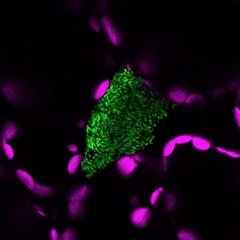
Credit: Tatsuya Nobori
By analysing the different layers of bacterial gene expression during pathogen infection of a plant host, Kenichi Tsuda and colleagues from the Max Planck Institute for Plant Breeding Research in Cologne, Germany and Huazhong Agricultural University in Wuhan, China have revealed new insights into bacterial gene regulation as well as the strategies employed by plants to target key bacterial processes.
Bacterial pathogens and their plant hosts engage in complex interactions mediated by changes in the expression of bacterial virulence and plant immune components. Understanding this interplay is critical for an integrated understanding of how bacteria cause disease and how plants protect themselves from infection. However, studies examining the response of pathogenic bacteria to plant immune activation have been few and far between owing to two main bottlenecks. One challenge with profiling bacterial responses inside their plant hosts is isolating bacterial RNA, the molecule that transfers the genetic information from the DNA blueprint to active proteins, from the large sea of plant material. To overcome this obstacle, first authors Tatsuya Nobori, Yiming Wang and colleagues made use of their own previously established method for enriching bacterial RNA from plant leaves. However, levels of RNA are often poor predictors of protein levels, and to tackle this problem, Nobori, Wang, and co-workers analysed both the expression of RNA as well as protein and correlated these with each other.
To analyse bacterial gene expression patterns during infection, the authors used the well-characterised bacterial pathogen Pseudomonas syringae and the model plant Arabidopsis thaliana. Nobori, Wang, and co-workers found large differences between both RNA and protein levels of P. syringae when they were inoculated into plants compared with bacteria grown in the lab, particularly early during the plant-bacterial interaction, which suggests that these early patterns of bacterial gene expression are crucial for the outcome of infection.
To determine the role of plant immunity in shaping bacterial gene expression, the authors made use of mutant plants in which specific branches of the immune system were compromised and analysed the different categories of genes whose expression was affected. This analysis showed that plant immune signalling controlled by the hormone salicylic acid (SA) suppresses bacterial mRNAs and proteins that promote pathogenesis.
The authors’ collection of bacterial RNA and protein expression data allowed them to determine the impact of the SA pathway on bacterial mRNAs and/or proteins during bacterial infection. They observed a generally high level of agreement, which suggests that the SA pathway targets bacterial mRNA expression. Notably, they also found that the SA-mediated arm of plant immunity specifically targets proteins that form the tip of an ‘injector’ used by bacteria to deliver their virulence proteins inside host cells and that the same branch of plant immunity also highly suppresses protein but not mRNA expression of factors related to bacterial movement.
The wealth of expression data generated by the Tsuda and his team also allowed them to address how individual bacterial genes are regulated during infection. To do this, they correlated the expression of over 4,500 genes with each other and clustered together those genes that exhibit similar patterns of expression. This approach yielded two important insights: first, the co-expression analysis allowed them to identify previously unknown bacterial gene clusters that contribute to bacterial growth; second, by observing that groups of highly co-expressed genes also contained known transcriptional regulators of these clusters, the authors could successfully predict previously unknown transcriptional regulators and validate that these did in fact control bacterial gene expression and virulence.
Co-first author Nobori emphasises that the authors’ approach for analysing the flow of bacterial genetic information during plant infection can potentially also be applied to the interactions of crop species with pathogenic bacteria: “Identifying the tactics used by bacteria to establish infection as well as plant counterstrategies would suggest interventions for optimizing crop breeding.”
###
Media Contact
Kenichi Tsuda
[email protected]
Related Journal Article
http://dx.




